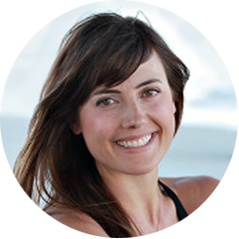Expert Advice
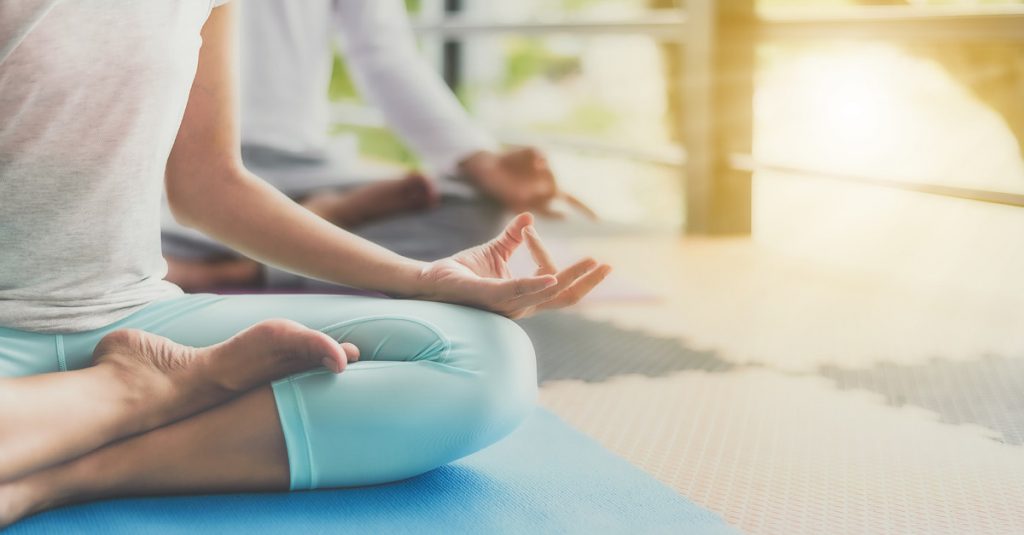
Acella Pharmaceuticals, LLC., is partnering with Lexi Hawks, a E-RYT 500 Hr Yoga Alliance Certified Teacher, to bring greater awareness to the importance of thyroid care and education. This post was sponsored by Acella Pharmaceuticals and should not be construed as medical advice. Please talk to your doctor about your individual medical situation.
This day in age it has become a cultural norm to fill our schedules from the moment we wake to the moment we sleep. Even when we try to maintain a sense of harmony in our personal and professional lives, stress can strike at any point. In fact, experiencing stress is a natural part of being human, but we are not always taught how to deal with stress in a healthy manner or to mitigate its effects. Not many people take time for daily or weekly purposeful relaxation, but what if I told you that with a little planning, you could do three yoga poses a day (or a few times a week) and change your relationship with stress? Yes, I see the irony of adding one more thing to your to-do list, but I promise this one is a game changer, particularly for patients with hypothyroidism.
For the following three postures, I recommend wearing comfortable clothing and using a yoga mat, a blanket or two, a yoga bolster or dense pillow, and two yoga blocks. These yoga postures are geared toward relaxation. Find a quiet time to try these poses and limit distractions. These postures are perfect right before bed or for an afternoon recharge. Take one blanket and fold it in half vertically and place it on top of your yoga mat, running the length of the mat to fully cover it. This will help to cushion the mat and make it a little more inviting and comfortable.
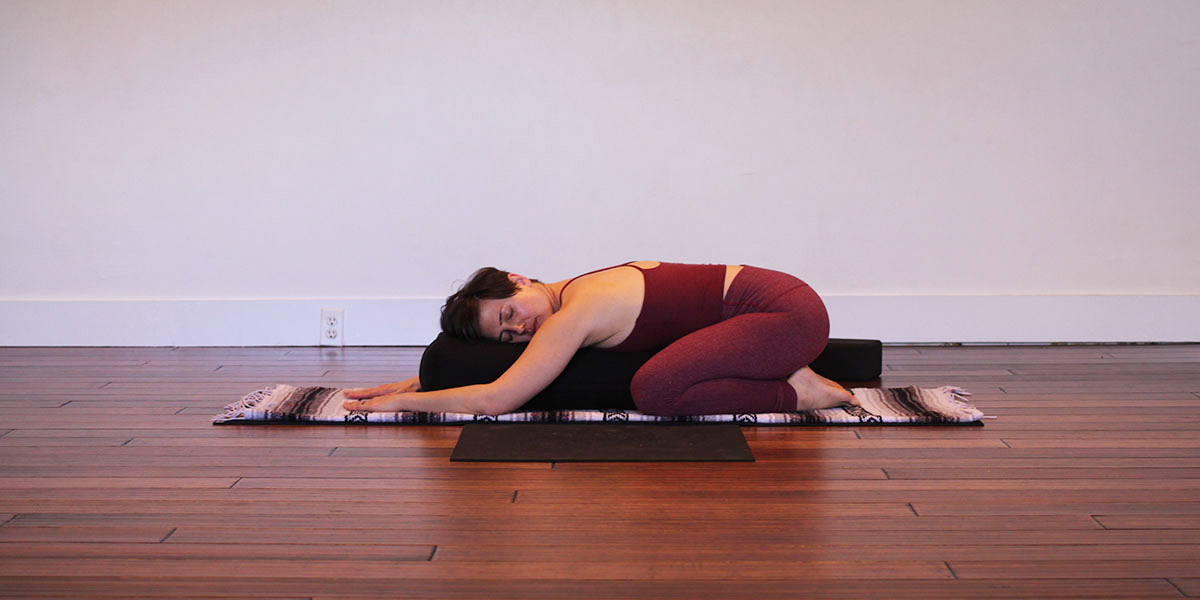
Child’s Pose: Balasana
Place yourself on the mat/blanket in a tabletop pose (on hands and knees). Bring your big toes together and your knees apart hip width or slightly wider. Bring your seat to the heels and walk your hands forward to fold your torso between your legs. Your arms will reach forward and your forehead will come to rest on either a block or the floor. You can also try a variation with your bolster placed between your thighs, allowing your torso and head to rest on the prop (shown in the photo below). If you have orthopedic considerations for your knees, try placing your bolster on top of your calves and heels.
Your seat will come to rest on the prop, helping to keep space behind your knee joints. You can also try rolling a blanket into a round bolster to place behind your knees. This is a great alternative to a bolster. If you experience tension in the front of -s, use a blanket to roll a small bolster like support to place under the front of both ankles. It’s important to have your body fully supported, so once you are in the pose you can stay here for at least one minute (deep breaths) or longer if you wish. This is a wonderful pose to focus on letting go of physical, mental or emotional tension and to allow the body to soften.
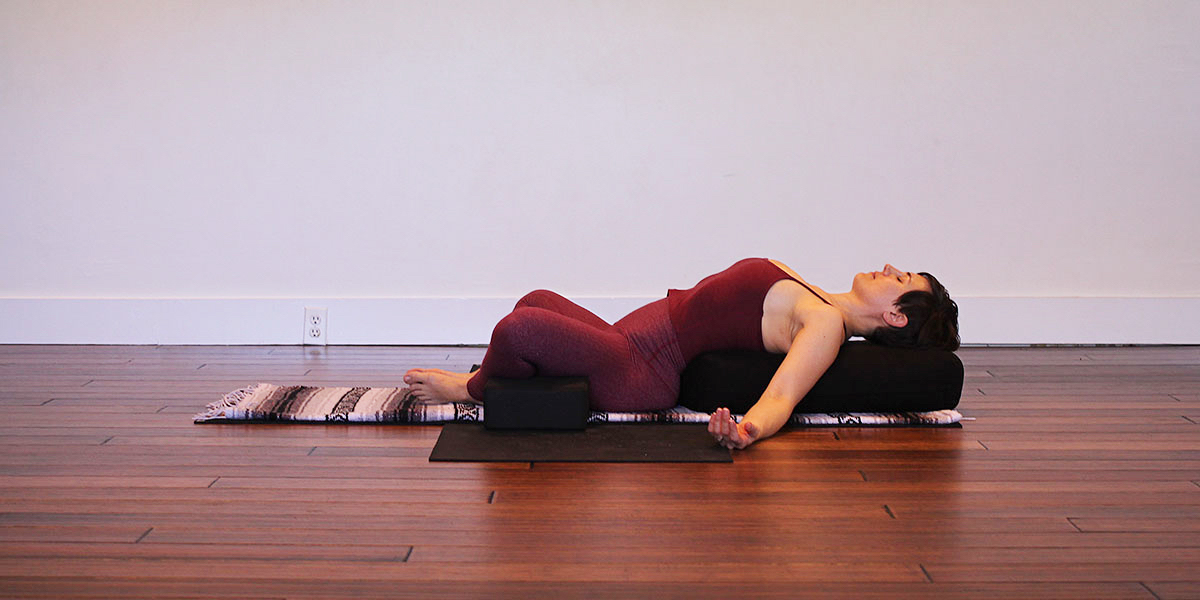
Reclining Bound Angle Pose: Supta Baddha Konasana
For this pose you will need a bolster (or firm pillow), two blocks and possibly a blanket.
Take a seat on your yoga mat and blanket setup and place the bolster behind you with the short end of it perpendicular to your back. Give about 3 to 4 inches of space between your low back and sacrum area and the short end of the bolster.
Bring the soles of your feet together with your knees out wide. Your legs will form a diamond shape. Take the yoga blocks and place them on the medium or highest level on the outer line of the low thigh/knee region. You will want your legs supported by the blocks so that your knees are lifted higher than your hips. This will allow your thigh bone to be on an angle, with the weight sliding toward your hip sockets.
Sit tall and bring your cupped hands behind your hips. Press your fingertips into the floor to help feel length in the sides of your torso and spine. While maintaining a long spine and torso, gently start to walk your hands back as you recline your back onto the bolster. You might find that the neck and head will be better served with the extra support of a folded blanket.
Once reclined, let the arms rest out to the sides, palms face up, and shoulder blades tucked under and smoothed to the bolster. You will feel an expansion in the front of your chest. Let your eyes rest and stay in this pose and enjoy slow, deep breathing for 2 to 5 minutes. This is a wonderful pose to acknowledge gratitude or offer self-compassion.
Corpse Pose: Shavasana
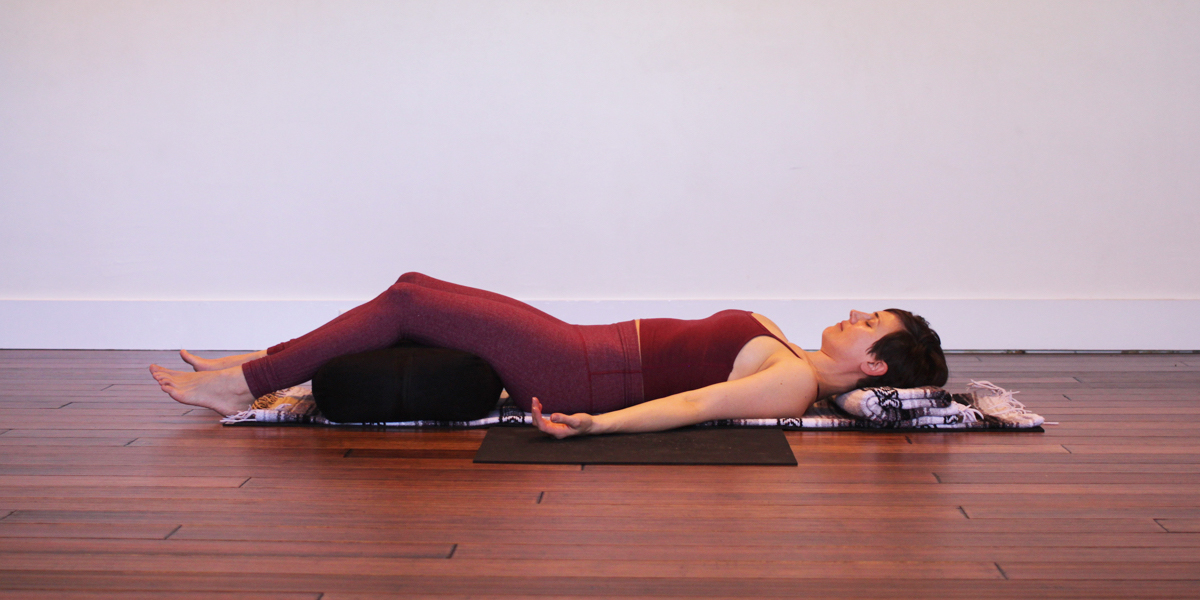
Shavasana Modified
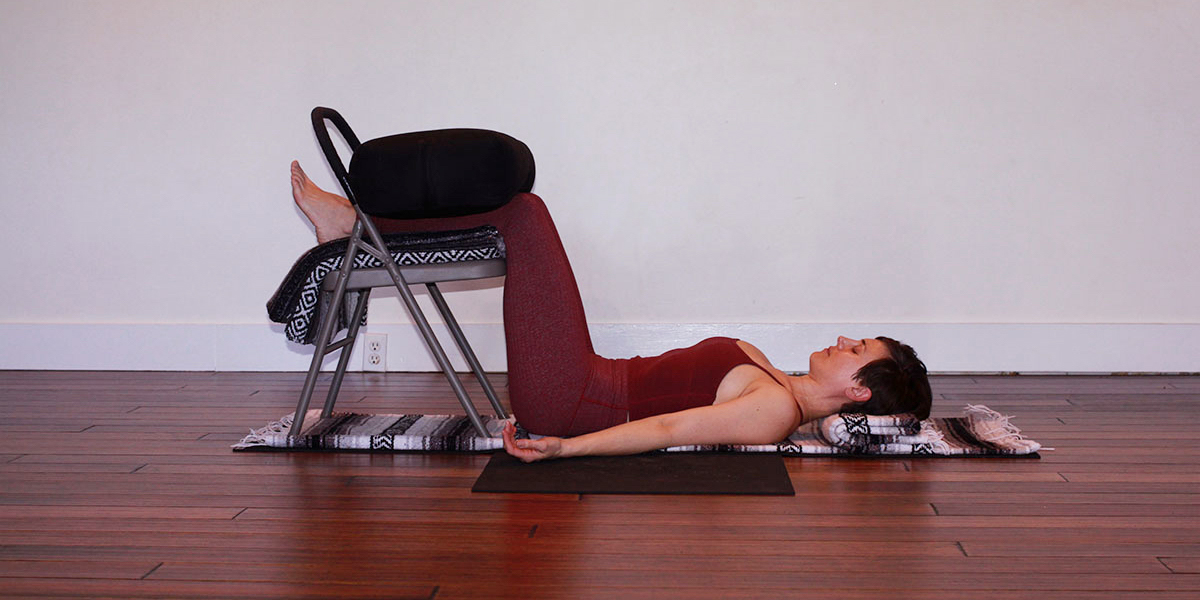
This might be one of the most important yogic postures, and also possibly the most resisted by busy people. This pose is not synonymous with sleeping (though you might fall asleep in it)! I’ll even go as far as to say that the busier your life and mind are, the more important it is to practice Shavasana.
Lay on your back with your legs extended out and relax them naturally from your hips to your heels. Lay your arms down next to your sides with the palms facing up and your head centered. Close your eyes and soften your entire body. Allow your breathing to be natural. Rest as each part of your body relaxes and softens toward the ground. Remain here for 5 minutes or longer if desired.
If your back aches when you lie down, try placing a bolster under your knees and low thighs. You might also find a blanket useful for supporting your neck and head. You can also try taking your lower legs onto a support like a chair or ottoman, as shown in the second photo.
Shavasana is a pose that’s intended for deep rest and relaxation. Allow yourself to move through layers and stages of softening and letting loose in the pose. This pose, like many yoga poses, will take time to understand and “do.” If you fall asleep, do not worry. Your body is saying it needs sleep. Eventually you will be able to take this pose without falling to sleep, and you will receive the benefits of taking a purposeful relaxation pose.
A regular yoga practice will help reduce tension and build resiliency physically, emotionally and energetically. Even three simple yoga poses can be effective in helping to reduce stress, refocus your mind and center your mood. Try them out and let us know how you feel!
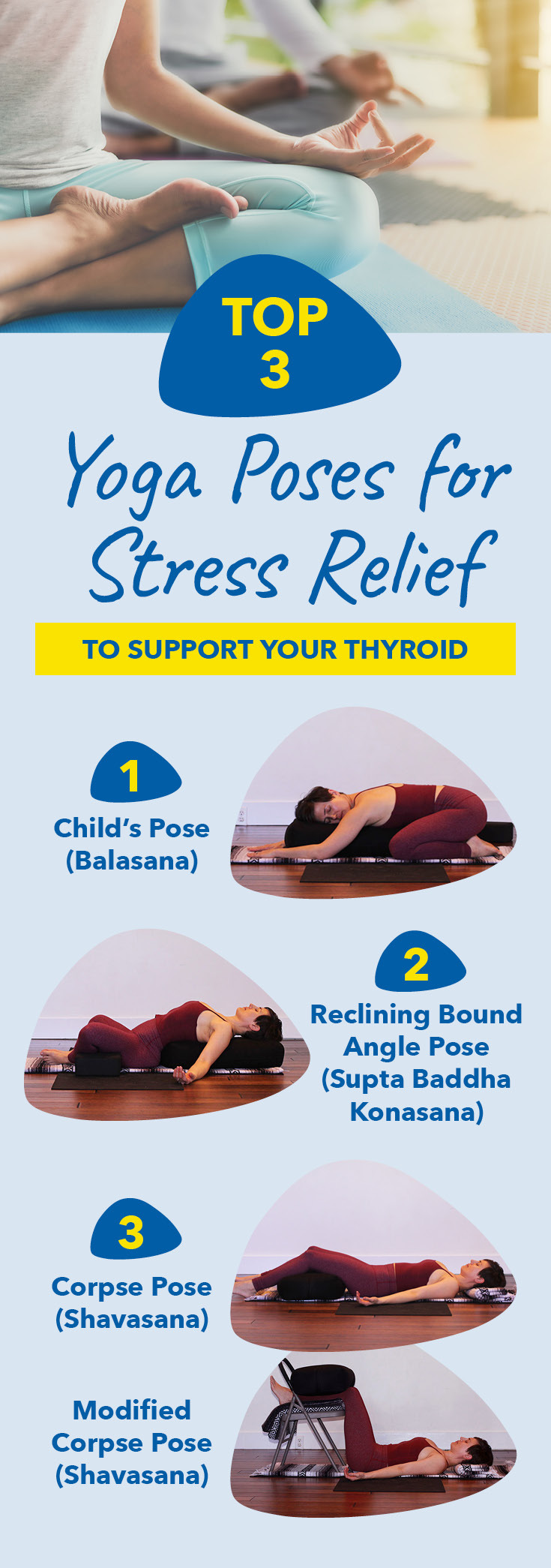
Note that DTE products, including NP Thyroid®, have not been reviewed by the FDA for safety or efficacy.
IMPORTANT RISK INFORMATION, INCLUDING BOXED WARNING & INDICATIONS
Important Risk Information
Drugs with thyroid hormone activity, alone or together with other therapeutic agents, have been used for the treatment of obesity. In euthyroid patients, doses within the range of daily hormonal requirements are ineffective for weight reduction. Larger doses may produce serious or even life-threatening manifestations of toxicity, particularly when given in association with sympathomimetic amines such as those used for their anorectic effects.
- NP Thyroid® is contraindicated in patients with uncorrected adrenal insufficiency, untreated thyrotoxicosis, and hypersensitivity to any component of the product.
- In the elderly and in patients with cardiovascular disease, NP Thyroid® should be used with greater caution than younger patients or those without cardiovascular disease.
- Use of NP Thyroid® in patients with diabetes mellitus or adrenal cortical insufficiency may worsen the intensity of their symptoms.
- The therapy of myxedema coma requires simultaneous administration of glucocorticoids.
- Concomitant use of NP Thyroid® with oral anticoagulants alters the sensitivity of oral anticoagulants. Prothrombin time should be closely monitored in thyroid-treated patients on oral anticoagulants.
- In infants, excessive doses of NP Thyroid® may produce craniosynostosis.
- Partial loss of hair may be experienced by children in the first few months of therapy but is usually transient.
- Adverse reactions associated with NP Thyroid® therapy are primarily those of hyperthyroidism due to therapeutic overdosage.
- Many drugs and some laboratory tests may alter the therapeutic response to NP Thyroid ®. In addition, thyroid hormones and thyroid status have varied effects on the pharmacokinetics and actions of other drugs. Administer at least 4 hours before or after drugs that are known to interfere with absorption. Evaluate the need for dose adjustments when regularly administering within one hour of certain foods that may affect absorption.
- NP Thyroid® should not be discontinued during pregnancy, and hypothyroidism diagnosed during pregnancy should be promptly treated.
Indications
NP Thyroid® (thyroid tablets, USP) is a prescription medicine that is used to treat a condition called hypothyroidism from any cause, except for cases of temporary hypothyroidism, which is usually associated with an inflammation of the thyroid (thyroiditis). It is meant to replace or supplement a hormone that is usually made by your thyroid gland.
NP Thyroid® is also used in the treatment and prevention of normal functioning thyroid goiters, such as thyroid nodules, Hashimoto’s thyroiditis, multinodular goiter, and in the management of thyroid cancer.
Revised
10/2023
You Are About To Leave This Website
By clicking continue, this link will take you to a website to which Alora Pharmaceuticals’ Policies & Terms of Use do not apply.
